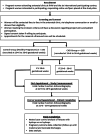Fetal cardiac function in pregnancy affected by congenital heart disease: protocol for a multicentre prospective cohort study
- PMID: 39885422
- PMCID: PMC11780818
- DOI: 10.1186/s12884-025-07145-7
Fetal cardiac function in pregnancy affected by congenital heart disease: protocol for a multicentre prospective cohort study
Abstract
Background: Congenital heart disease (CHD) is the most common fetal malformation, and it can result first in cardiac remodeling and dysfunction and later in cardiac failure and hydrops. A limited number of studies have evaluated cardiac function in fetuses affected by CHD. Functional parameters could potentially identify fetuses at risk of cardiac failure before its development. However, these techniques have not translated from research to clinical settings, due to a lack of standardization and poor repeatability. We seek to evaluate whether application of automated techniques to a cohort with fetal pathology could overcome these factors.
Methods: A multicenter cohort study will be carried out in eight teaching hospitals across Europe, Australia, and Middle East. Based on a previous observed standard deviation, a total sample of 381 pregnancies is required to achieve 80% power to detect a difference of 0.03 in mean myocardial performance index (MPI) with a two-sided type I error rate of 5%. After adjustments allowing for patient exclusions or incomplete datasets, a total of 330 healthy singleton pregnancies and 165 diagnosed with CHD will be recruited. Two fetal cardiac function evaluations at 19 + 6-28 + 6 and 32 + 6-36 + 6 weeks will be offered assessing automated pulsed wave doppler (PWD) MPI, spatio-temporal image correlation (STIC) annular and septal plane excursion (TAPSE, MAPSE and SAPSE), alongside cardiac morphometric and Doppler evaluations of flow across the valves. A secondary nested case-control study will evaluate fetuses with hydrops compared to those without. Differences in functional parameters between cases and controls and over time will be assessed using generalized linear mixed models. Logistic regression will estimate the association between cardiac parameters and hydrops' incidence.
Discussion: This study will provide evidence as to whether automated functional parameters could be significantly different in pregnancy affected by CHD versus healthy pregnancies. The primary objective is to compare automated PWD-MPI and STIC TAPSE, MAPSE and SAPSE in fetuses affected by CHD versus healthy. The secondary objective is to estimate whether these automated parameters could improve the predictive value of the classical cardiovascular profile score in case of hydrops.
Trial registration: The study protocol has been registered in the ClinicalTrials.gov Protocol Registration System, identification number NCT05698277.
Keywords: Automated fetal cardiac function; MAPSE; MPI; SAPSE; TAPSE.
© 2025. The Author(s).
Conflict of interest statement
Declarations. Ethics approval and consent to participate: This study obtained ethical approval (2022/ETH00943) by the South Eastern Sydney Local Health District Human Research Ethics Committee. The research will be performed in accordance with the Declaration of Helsinki. Informed consent will be obtained from all the participants. Consent for publication: Not applicable. Competing interests: The authors declare no competing interests.
Figures


References
-
- Crispi F, Sepúlveda-Martínez Á, Crovetto F, Gómez O, Bijnens B, Gratacós E. Main patterns of fetal cardiac remodeling. Fetal Diagn Ther. 2020;47(5):337–44. - PubMed
-
- Cohn JN, Ferrari R, Sharpe N. Cardiac remodeling–concepts and clinical implications: a consensus paper from an international forum on cardiac remodeling. Behalf of an International Forum on Cardiac Remodeling. J Am Coll Cardiol. 2000;35(3):569–82. - PubMed
-
- Walter C, Soveral I, Bartrons J, Escobar MC, Carretero JM, Quirado L, et al. Comprehensive functional echocardiographic assessment of transposition of the great arteries: from fetus to newborn. Pediatr Cardiol. 2020;41(4):687–94. - PubMed
Publication types
MeSH terms
Associated data
LinkOut - more resources
Full Text Sources
Medical

